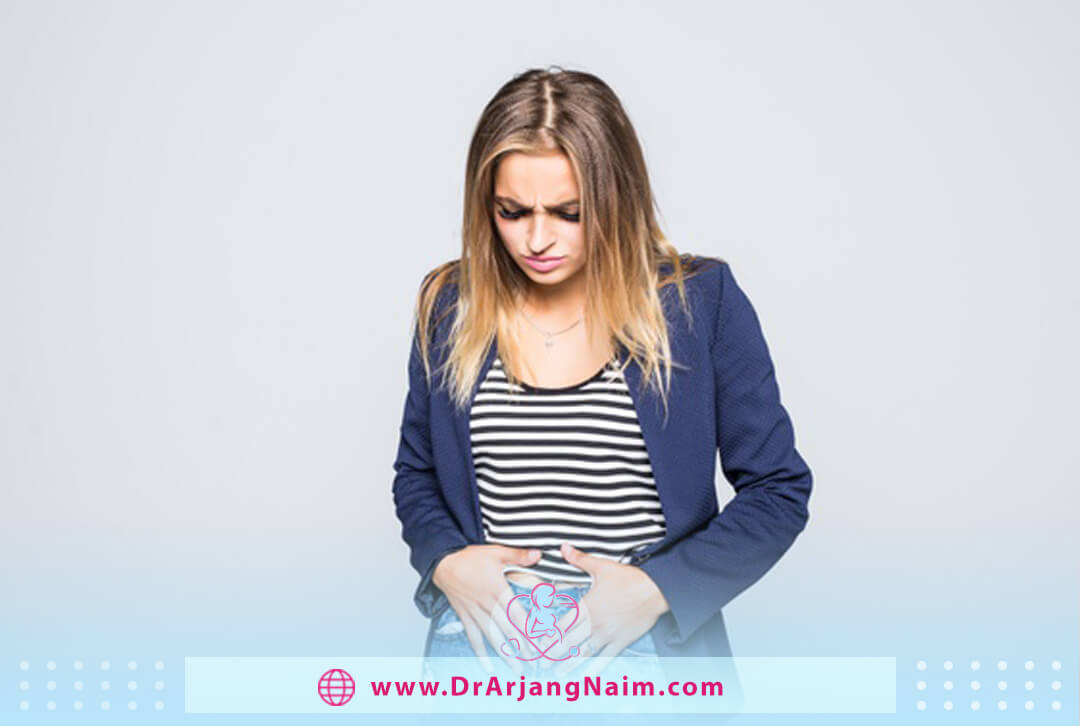Uterine artery embolization (UAE) is a minimally invasive treatment for uterine fibroids, and noncancerous growth in the uterus. A fibroid is muscle tissue in the uterus that grows abnormally and forms a mass. These lumps can grow in different places, but the most common is in the uterine wall. These tumors can be as large as 10 cm and may be numerous.
In this method, several blocking substances are injected into the uterine fibroid artery, which blocks these blood vessels. Therefore, the uterine fibroid mass becomes necrotic and inactive by cutting off blood supply and oxygen.
What is (UAE)?
Uterine fibroids can cause severe symptoms in some women, including heavy menstrual bleeding, pelvic pain, and bloating. Uterine artery embolization destroys fibroid tissue and relieves these symptoms, providing an alternative surgery to remove the fibroid (myomectomy). UAE is a method of shrinking non-cancerous tumors in the uterus called uterine fibroids. It does not use major surgery, so may recover faster.
Uterine fibroid embolization shrinks fibroids by blocking blood flow. The doctor injects very fine particles, such as sand, into the vessels that supply the fibroids. The particles stick to the wall of the vessel. This causes a clot that blocks blood flow. When blood flow is lost, the fibroids shrink. symptoms usually decrease over time or disappear. Different types of particles are used to embolize uterine fibroids.
Three main types of uterine fibroids are classified based on their location in the uterus, which include:
- Subserosal Fibroids: These types of fibroids form on the outside of the uterus and grow outward.
- Intramural Fibroids: It is the most common type that develops and spreads in the uterine wall.
- Submucosal Fibroids: These types of fibroids are less common and develop in the uterine cavity, causing excessive and prolonged menstrual bleeding.
- Pedunculated fibroids: Pedunculated fibroids grow on stalks or stems. These stems attach to the wall of the uterus and can grow outside the uterus or inside the uterine cavity.
Symptoms of uterine fibroids

In some women, the fibroid may have mild or no symptoms. For others, symptoms of uterine fibroids include significant pain and heavy bleeding. For these reasons alone, treatment of uterine fibroids is a priority for most women seeking symptom relief. In women who have symptoms, the most common signs and symptoms of uterine fibroids are:
- Heavy menstrual bleeding
- Menstrual periods lasting more than a week
- Pelvic pressure or pain
- Frequent urination
- Difficulty emptying the bladder
- Constipation
- Backache or leg pains
If there are some symptoms, options for the type of treatment are available. When considering different treatment options for fibroids, should evaluate the risks and benefits of each procedure.
Who needs uterine artery embolization?
Women who experience severe pelvic bleeding as a result of fibroids or other conditions may benefit from UAE. uterine artery embolization should not be performed:
- When the patient has asymptomatic uterine fibroids
- If the woman is pregnant
- If cancer may be present
- In cases of allergic reaction to contrast dyes
- In cases of pelvic infection
Risks

Rarely, do major complications occur in women undergoing uterine artery embolization. The risk of complications (UAE) is almost the same as in the surgical treatment of fibroids.
Infection
Destructive fibroids can provide a breeding ground for bacteria and lead to uterine infection. Many uterine infections can be treated with antibiotics, but in severe cases, the infection may require removal of the uterus.
Damage to other organs
Unwanted embolization of another organ or tissue can occur, although the risk is not as great as surgery. In the case of embolism and surgery, disruption of ovarian blood flow is possible because the ovaries and uterus are shared by some blood vessels. If you are approaching menopause, such a disorder can lead to menopause, but it is rare at age 40 or younger.
Possible problems in future pregnancies
Many women have a healthy pregnancy after uterine artery embolization. However, there is some evidence that pregnancy complications, including placental abnormalities attached to the uterus, may increase after surgery.
Other possible side effects include:
- Abnormal bleeding
- Collection of blood under the skin
- Loss of menstrual period
Some women have the post-embolization syndrome, which includes:
- Pelvic pain and cramping
- Nausea and vomiting
- Low-grade fever
- Fatigue and discomfort
Symptoms of the syndrome after embolization may last 2 to 7 days. It is treated with painkillers and anti-inflammatory drugs. Medication may also be used to help with nausea.
Reasons for not using uterine artery embolization
Prevent uterine artery embolization if:
- Pregnant
- Have possible pelvic cancer
- Have an active, recent, or chronic pelvic infection
- Have a condition that affects blood vessels
- Are allergic to contrast material containing iodine
Before the procedure
In the radiology operating room, the patient has an intravenous (IV) line to place fluids, anesthetics, antibiotics, and analgesics in one of their arteries.
During the procedure
The procedure includes:
- Anesthesia: The patient usually receives an anesthetic that reduces pain and helps to relax, but is awake.
- Blood vessel access: The doctor makes a small incision in the skin over the femoral artery, a large blood vessel that runs the length of the groin. The doctor then inserts a catheter into the vein and guides the catheter into one of the two uterine vessels. In general, the doctor can access both uterine arteries through an incision.
- Blood vessel mapping and injection: An injectable contrast fluid, usually containing iodine, pours into the uterine artery and its branches and makes them visible through a fluoroscopic monitor. Fibroids become “brighter” than other uterine tissues.
The radiologist identifies the right area of the uterine artery and then injects the blood vessels with tiny particles made of plastic or gelatin. These particles are carried by the bloodstream to block fibroid vessels.
After injecting more contrast into the uterine artery, the doctor examines the extra images to make sure the blood is no longer reaching the fibroids. The same steps are then repeated in the second uterine artery.
After the procedure
In the recovery room, the care team monitors the condition and gives the patient medication to control nausea and pain.
The patient should lie down for several hours to prevent blood from collecting (hematoma) at the site of the femoral artery. Pain is the primary side effect of uterine artery embolization, which may be a reaction to the cessation of blood flow in the fibroid and a temporary drop in blood flow to the normal tissues of the uterus. The pain usually peaks within the first 24 hours. To control the pain, the patient receives pain medication.
Get enough rest after the UAE, walk every day, and increase the amount of walking every day compared to the previous day. Walking increases blood flow and prevents pneumonia and constipation. Avoid lifting anything that causes fatigue for one week. Avoid strenuous activities such as cycling, jogging, weightlifting, and aerobic exercise for four weeks. There may be some vaginal bleeding; use a sanitary pad if needed.
Advantages of uterine artery embolization
The benefits of this method include:
- Can be performed under local anesthesia
- The short period of recovery
- Avoids the side effects of hormone therapies
- Little blood loss or bleeding afterward
- Needs only a tiny incision, making it less invasive than other treatments
- Nearly 90 percent of women treated with UAE experience partial or full relief of symptoms
Results
Uterine artery embolization usually relieves significant symptoms. It also affects menstruation and may affect fertility.
Symptom relief
Most women experience significant relief in the first three months after treatment. In addition, some research shows that five years after treatment, symptoms such as heavy bleeding, urinary incontinence, and abdominal enlargement decrease in most women. These results appear to be comparable to myomectomy, in which fibroids are surgically removed and the uterus repaired.
Menstruation
Menstruation may continue according to the normal schedule. It will probably return in a few months if any period is missed. A small number of women go through menopause after surgery. This risk is higher among women 45 and older.
Impact on fertility
The effect of fibroids in pregnancy is one of the issues that bother women.Although the risk of menopause after surgery is low, subtle ovarian damage can make pregnancy more difficult. There may also be an increased risk of pregnancy complications, especially involving abnormal placement or attachment of the placenta. Despite these risks, many women have had successful pregnancies after uterine artery embolization.
The bottom line
Embolization is one of the less invasive methods for treating uterine fibroids. A fibroid is the muscle tissue of the uterus; if it grows abnormally, forms lumps that are mostly located in the wall of the uterus.
The number and size of these masses vary and may be from one to ten centimeters. It is estimated that 20 to 50 percent of women of childbearing age have fibroids and may not have any discomfort or pain, and something may be seen on ultrasound. But in some women, it can cause severe pelvic pain, abnormal bleeding, urinary problems, or even infertility. Abnormal bleeding is the most common reason for patients to see a doctor for fibroids. UAE is a minimally invasive procedure used to treat uterine fibroids. Embolization is a good alternative to surgery for fibroids or myomectomies.
Dr. Arjang Naim MD first examines the symptoms, type, and size of the fibroid, and after a thorough examination, suggests the best treatment for the patient.
Additional questions
- Can Menometrorrhagia cause infertility?
Menorrhagia may be associated with infertility in the following conditions:
- Hysterectomy (removal of uterus)
- Menorrhagia caused by cancer
- Adenomyosis
- Does pelvic pain feel like cramps?
In some people, pelvic pain may be a symptom of menstrual cramps, ovulation, or digestive problems such as food intolerances.Sometimes, pelvic pain indicates an infection or problem in the genital tract or other organs in the area.
- What are people allergic to in contrast?
Allergic reactions to IV dye are common, can range from mild to moderate, and can sometimes be life-threatening. People who are allergic to seafood may also be allergic to contrast agents, due to the presence of iodine in both.
- What are the 3 main types of anesthesia?
- Local Anesthesia
- Regional Anesthesia
- General Anesthesia
5. How long does a uterine artery embolization last?
Fibroid embolization typically lasts one to two hours.
References:
https://my.clevelandclinic.org/health/treatments/17954-uterine-artery-embolization
https://medlineplus.gov/ency/article/007384.htm
https://www.uclahealth.org/medical-services/fibroids/treatment-options/uterine-artery-embolization
https://www.hopkinsmedicine.org/health/treatment-tests-and-therapies/uterine-artery-embolization
https://www.ucsfhealth.org/treatments/uterine-artery-embolization




